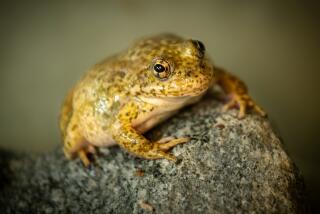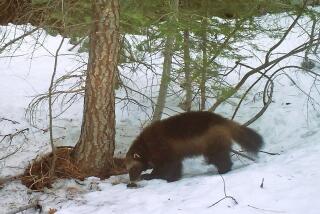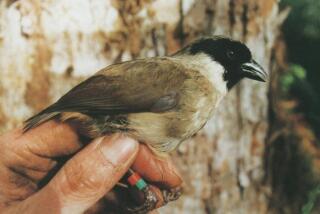Near Extinction, 50 Captive-Bred Ferrets to Be Freed
WASHINGTON — Just north of Medicine Bow, Wyo., in a 4,000-acre basin pockmarked with scores of prairie-dog towns, wildlife biologists have begun preparations for what could prove to be one of the triumphant moments in the stormy history of the Endangered Species Act.
Cages are being moved into place to release 50 captive-bred black-footed ferrets, believed to be extinct in the wild, back to their native hunting grounds--the climactic step toward saving a critter that only five years ago was the United States’ most endangered mammal.
Once ranging the high plains from northern Texas and New Mexico to Montana and North Dakota, the ferret was brought to the brink of extinction when ranchers largely exterminated its principal prey, the pesky prairie dog.
Years passed between sightings of the solitary little night stalker with the lithe body of a mink and the masked face of a cartoon burglar. Wildlife experts searched tens of thousands of prairie-dog holes, their hopes kept alive by an occasional track, a skull or ferret scat.
But efforts at captive breeding during the 1970s failed. In 1979, the last two animals in captivity died.
Rediscovered in 1981 in prairie-dog towns near Meeteetse, Wyo., the only known surviving population was thought to be growing for a time, but an outbreak of sylvatic plague decimated the prairie dogs, and surviving ferrets were almost wiped out by canine distemper.
By the fall of 1985, the number of ferrets had plunged to 18. In desperation, the Wyoming Fish and Game Department began capturing the last survivors, with uncertain hopes at best of producing offspring in captivity.
Efforts to trap the last remaining male, in 1986-87, took all winter.
Now, after five years of heroic effort and a generous portion of good luck, the captive population has been built up to about 325.
And, with breeding programs at seven sites from Virginia to Wyoming, the U.S. Fish and Wildlife Service hopes to have 1,500 ferrets back in the wild 20 years from now at as many as 10 different locations.
Tom Dougherty, western regional director of the National Wildlife Federation, said that the ferret’s return to the wild “is evidence that the Endangered Species Act does what its authors intended it to do--protect and recover endangered species.”
The reintroduction of the ferret comes in the wake of successful captive breeding and release of the red wolf and only a few months before first release of captive-bred California condors.
On Easter Sunday, 1987, the last known California condor was captured, and in the intervening four years captive breeding has produced 25 condor chicks.
In October, two of them will be placed in conditioning pens near the Ventura-Kern county line in the Los Padres National Forest awaiting release in midwinter.
Still, of all the captive breeding programs undertaken thus far, none has been more delicate than the effort to produce a viable ferret population.
Besides being temperamental, the animals are sensitive to diseases that cause high mortality even under ideal conditions in their native habitat.
Fish and Wildlife experts predict that more than 90% of those released will either die of disease or fall victim to owls, eagles, coyotes or other predators.
For thousands of years before extensive cattle ranching, ferrets and prairie dogs inhabited the same expanses of the West. With an adult ferret eating as many as 200 prairie dogs a year, population explosions of prairie dogs were averted.
But when poison and outbreaks of plague nearly wiped out prairie dogs, the ferret went into precipitous decline as well.
Faced with the threat that the ferret might become extinct, wildlife experts unsuccessfully tried to revive the species through artificial insemination, eventually learning enough about the ferrets’ breeding habits to allow them to produce litters.
Breeding stock was sent to widely dispersed locations to avoid the chance that the disease might wipe out all the remaining animals. And extraordinary measures--such as performing root-canal treatments on damaged teeth--were taken to save productive females.
Young ferrets born to females that failed to lactate were nursed by Siberian polecats that acted as surrogate mothers.
This week, state and federal experts began moving 25 “conditioning boxes,” each containing two offspring from last spring’s litters, into a 4,000-acre area well-infested with prairie dogs in southeastern Wyoming’s Shirley Basin.
They will remain caged for 10 days to become accustomed to the climate before artificial tunnels simulating prairie dog burrows are opened to permit them to leave.
At a gathering place on the perimeter of the basin Tuesday, state and federal officials will preside over ceremonies commemorating the achievement.
The released animals will wear radio collars enabling officials to track them for months after they have left their cages to stalk prairie dogs in the night. So far, the young ferrets have caught and killed only hamsters at the breeding stations.
If the reintroduction proves as successful as the captive breeding program, the chief problem in re-establishing the animal in the wild may be to find other sites where cattle owners and landowners are willing to cooperate.
Not surprisingly, one area under consideration for a future release is Meeteetse, where the last wild ferret was captured nearly five years ago.
More to Read
Sign up for Essential California
The most important California stories and recommendations in your inbox every morning.
You may occasionally receive promotional content from the Los Angeles Times.










